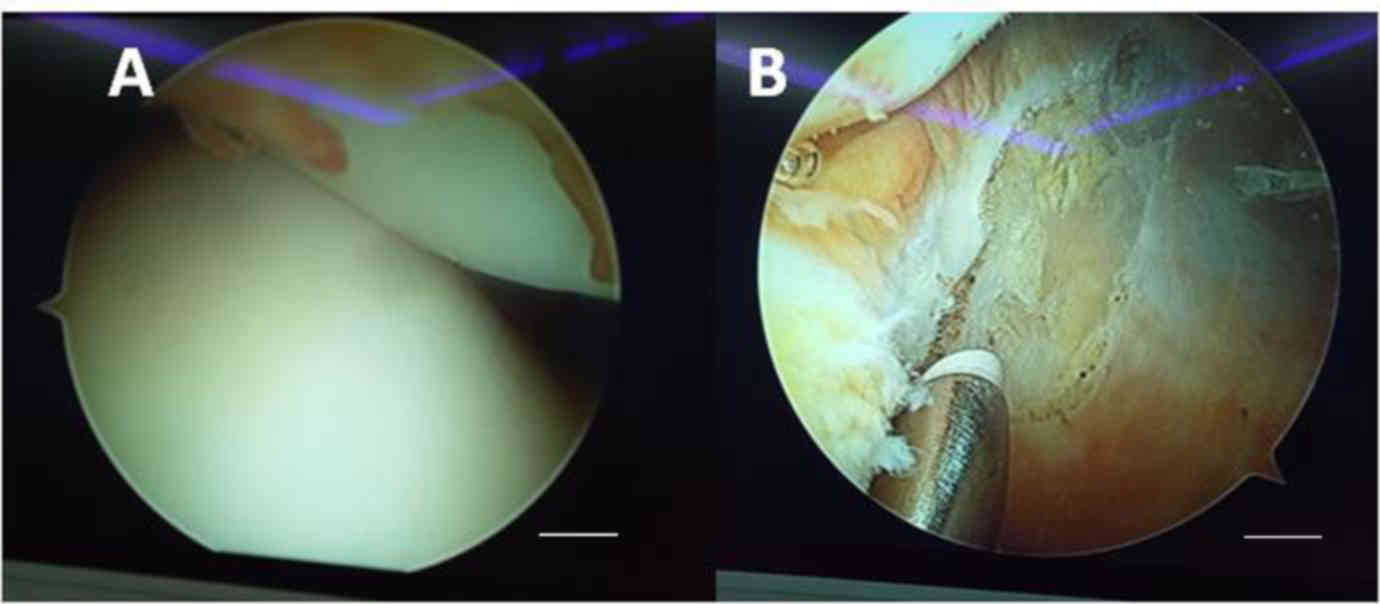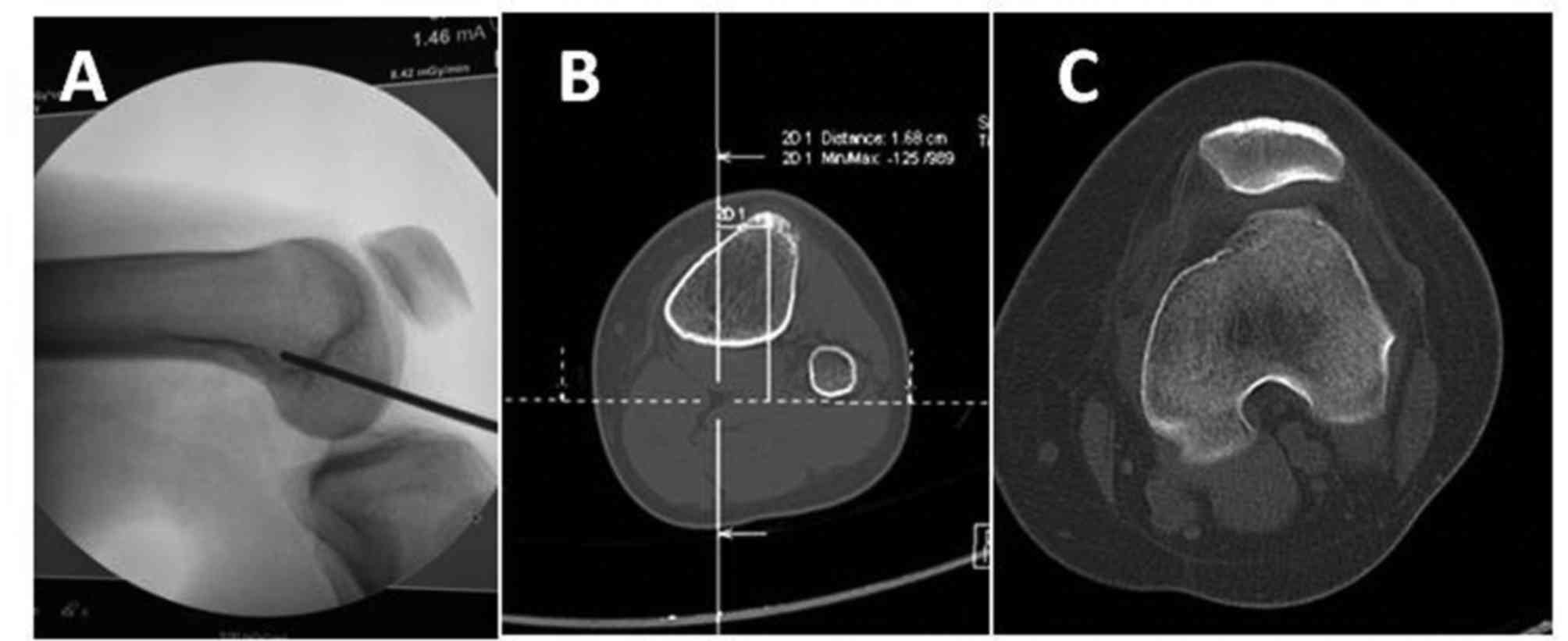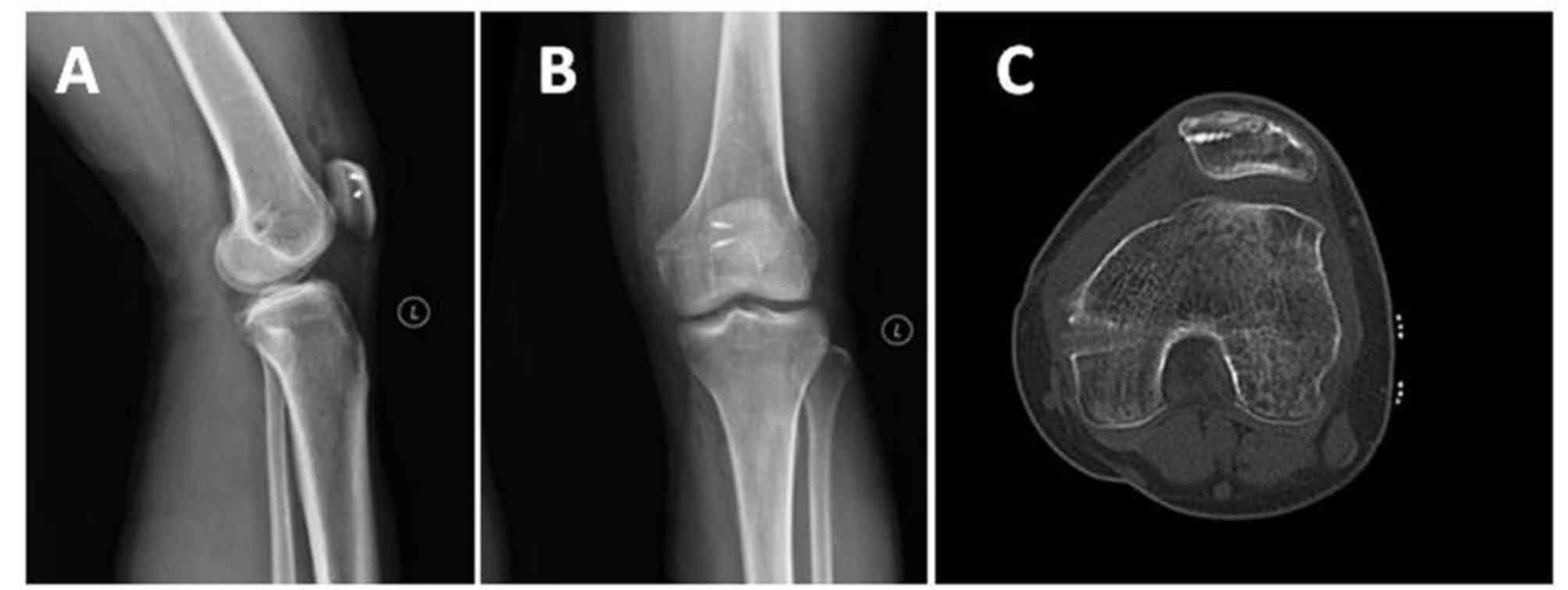|
1
|
Fithian DC, Paxton EW, Stone ML, Silva P,
Davis DK, Elias DA and White LM: Epidemiology and natural history
of acute patellar dislocation. Am J Sports Med. 32:1114–1121. 2004.
View Article : Google Scholar : PubMed/NCBI
|
|
2
|
Du H, Tian XX, Guo FQ, Li XM, Ji TT, Li B
and Li TS: Evaluation of different surgical methods in treating
recurrent patella dislocation after three-dimensional
reconstruction. Int Orthop. 41:2517–2524. 2017. View Article : Google Scholar : PubMed/NCBI
|
|
3
|
Gao B, Shi Y and Zhang F: Pediatric
patellar dislocation: a review. Minerva Pediatr. Mar 27–2017.(Epub
ahead of print).
|
|
4
|
Chang CB, Shetty GM, Lee JS, Kim YC, Kwon
JH and Nha KW: A combined closing wedge distal femoral osteotomy
and medial reefing procedure for recurrent patellar dislocation
with Genu Valgum. Yonsei Med J. 58:878–883. 2017. View Article : Google Scholar : PubMed/NCBI
|
|
5
|
Saccomanno MF, Sircana G, Fodale M, Donati
F and Milano G: Surgical versus conservative treatment of primary
patellar dislocation. A systematic review and meta-analysis. Int
Orthop. 40:2277–2287. 2016. View Article : Google Scholar : PubMed/NCBI
|
|
6
|
Cao WQ, Yang ZQ, Wang G, Men YX and Cheng
XY: Current therapy progress on the recurrent patellar dislocation.
Zhongguo Gu Shang. 30:282–286. 2017.(In Chinese). PubMed/NCBI
|
|
7
|
Zhao ZD, Li PC and Wei XC: Current status
and expectations in the surgical treatment of recurrent lateral
patellar dislocation. Zhongguo Gu Shang. 30:982–985. 2017.(In
Chinese). PubMed/NCBI
|
|
8
|
Chen S, Zhou Y, Qian Q, Wu Y, Fu P and Wu
H: Arthroscopic lateral retinacular release, medial retinacular
plication and partial medial tibial tubercle transfer for recurrent
patellar dislocation. Int J Surg. 44:43–48. 2017. View Article : Google Scholar : PubMed/NCBI
|
|
9
|
Gaweda K, Walawski J, Wegłowski R, Drelich
M and Mazurkiewicz T: Early results of one-stage knee extensor
realignment and autologous osteochondral grafting. Int Orthop.
30:39–42. 2006. View Article : Google Scholar : PubMed/NCBI
|
|
10
|
Chouteau J: Surgical reconstruction of the
medial patellofemoral ligament. Orthop Traumatol Surg Res. 102 1
Suppl:S189–S194. 2016. View Article : Google Scholar : PubMed/NCBI
|
|
11
|
Sallay PI, Poggi J, Speer KP and Garrett
WE: Acute dislocation of the patella. A correlative pathoanatomic
study. Am J Sports Med. 24:52–60. 1996. View Article : Google Scholar : PubMed/NCBI
|
|
12
|
Hinckel BB, Gobbi RG, Kaleka CC, Camanho
GL and Arendt EA: Medial patellotibial ligament and medial
patellomeniscal ligament: Anatomy, imaging, biomechanics, and
clinical review. Knee Surg Sports Traumatol Arthrosc. 26:685–696.
2018. View Article : Google Scholar : PubMed/NCBI
|
|
13
|
Ziegler CG, Fulkerson JP and Edgar C:
Radiographic reference points are inaccurate with and without a
true lateral radiograph: The importance of anatomy in medial
patellofemoral ligament reconstruction. Am J Sports Med.
44:133–142. 2016. View Article : Google Scholar : PubMed/NCBI
|
|
14
|
Dimon JH III: Apprehension test for
subluxation of the patella. Clin Orthop Relat Res. 39:1974.
|
|
15
|
Grawe B, Schroeder AJ, Kakazu R and Messer
MS: Lateral collateral ligament injury about the knee: Anatomy,
evaluation, and management. J Am Acad Orthop Surg 2018. Feb
13–2018.(Epub ahead of print). View Article : Google Scholar
|
|
16
|
Beaconsfield T, Pintore E, Maffulli N and
Petri GJ: Radiological measurements in patellofemoral disorders. A
review. Clin Orthop Relat Res. 18–28. 1994.PubMed/NCBI
|
|
17
|
Duchman K, Mellecker C, El-Hattab AY and
Albright JP: Case report: Quantitative MRI of tibial tubercle
transfer during active quadriceps contraction. Clin Orthop Relat
Res. 469:294–299. 2011. View Article : Google Scholar : PubMed/NCBI
|
|
18
|
Kellgren JH and Lawrence JS: Radiological
assessment of osteo-arthrosis. Ann Rheum Dis. 16:494–502. 1957.
View Article : Google Scholar : PubMed/NCBI
|
|
19
|
Schöttle PB, Schmeling A, Rosenstiel N and
Weiler A: Radiographic landmarks for femoral tunnel placement in
medial patellofemoral ligament reconstruction. Am J Sports Med.
35:801–804. 2007. View Article : Google Scholar : PubMed/NCBI
|
|
20
|
Weber AE, Nathani A, Dines JS, Allen AA,
Shubin-Stein BE, Arendt EA and Bedi A: An Algorithmic approach to
the management of recurrent lateral patellar dislocation. J Bone
Joint Surg Am. 98:417–427. 2016. View Article : Google Scholar : PubMed/NCBI
|
|
21
|
Fulkerson JP: Anteromedialization of the
tibial tuberosity for patellofemoral malalignment. Clin Orthop
Relat Res. 176–181. 1983.PubMed/NCBI
|
|
22
|
Fulkerson JP, Becker GJ, Meaney JA,
Miranda M and Folcik MA: Anteromedial tibial tubercle transfer
without bone graft. Am J Sports Med. 18:490–497. 1990. View Article : Google Scholar : PubMed/NCBI
|
|
23
|
Tegner Y and Lysholm J: Rating systems in
the evaluation of knee ligament injuries. Clin Orthop Relat Res.
43–49. 1985.PubMed/NCBI
|
|
24
|
Schorn D, Yang-Strathoff S, Gosheger G,
Vogler T, Klingebiel S, Rickert C, Andreou D and Liem D: Long-term
outcomes after combined arthroscopic medial reefing and lateral
release in patients with recurrent patellar instability-a
retrospective analysis. BMC Musculoskelet Disord. 18:2772017.
View Article : Google Scholar : PubMed/NCBI
|
|
25
|
Gravesen KS, Kallemose T, Blønd L,
Troelsen A and Barfod KW: High incidence of acute and recurrent
patellar dislocations: A retrospective nationwide epidemiological
study involving 24.154 primary dislocations. Knee Surg Sports
Traumatol Arthrosc. Jun 23–2017.(Epub ahead of print). View Article : Google Scholar : PubMed/NCBI
|
|
26
|
Clark D, Walmsley K, Schranz P and
Mandalia V: Tibial tuberosity transfer in combination with medial
patellofemoral ligament reconstruction: Surgical technique.
Arthrosc Tech. 6:e591–e597. 2017. View Article : Google Scholar : PubMed/NCBI
|
|
27
|
Joyner PW, Bruce J, Roth TS, Mills FB IV,
Winnier S, Hess R, Wilcox L, Mates A, Frerichs T, Andrews JR and
Roth CA: Biomechanical tensile strength analysis for medial
patellofemoral ligament reconstruction. Knee. 24:965–976. 2017.
View Article : Google Scholar : PubMed/NCBI
|
|
28
|
Hinckel BB, Gobbi RG, Demange MK, Pereira
CAM, Pécora JR, Natalino RJM, Miyahira L, Kubota BS and Camanho GL:
Medial patellofemoral ligament, medial patellotibial ligament, and
medial patellomeniscal ligament: Anatomic, histologic,
radiographic, and biomechanical study. Arthroscopy. 33:1862–1873.
2017. View Article : Google Scholar : PubMed/NCBI
|
|
29
|
Lind M, Jakobsen BW, Lund B and
Christiansen SE: Reconstruction of the medial patellofemoral
ligament for treatment of patellar instability. Acta Orthop.
79:354–360. 2008. View Article : Google Scholar : PubMed/NCBI
|
|
30
|
Schöttle PB, Fucentese SF and Romero J:
Clinical and radiological outcome of medial patellofemoral ligament
reconstruction with a semitendinosus autograft for patella
instability. Knee Surg Sports Traumatol Arthrosc. 13:516–521. 2005.
View Article : Google Scholar : PubMed/NCBI
|
|
31
|
Trillat A, Dejour H and Couette A:
Diagnosis and treatment of recurrent dislocations of the Patella.
Rev Chir Orthop Reparatrice Appar Mot. 50:813–824. 1964.(In
French). PubMed/NCBI
|
|
32
|
Tanaka MJ, Voss A and Fulkerson JP: The
anatomic midpoint of the attachment of the medial patellofemoral
complex. J Bone Joint Surg Am. 98:1199–1205. 2016. View Article : Google Scholar : PubMed/NCBI
|













